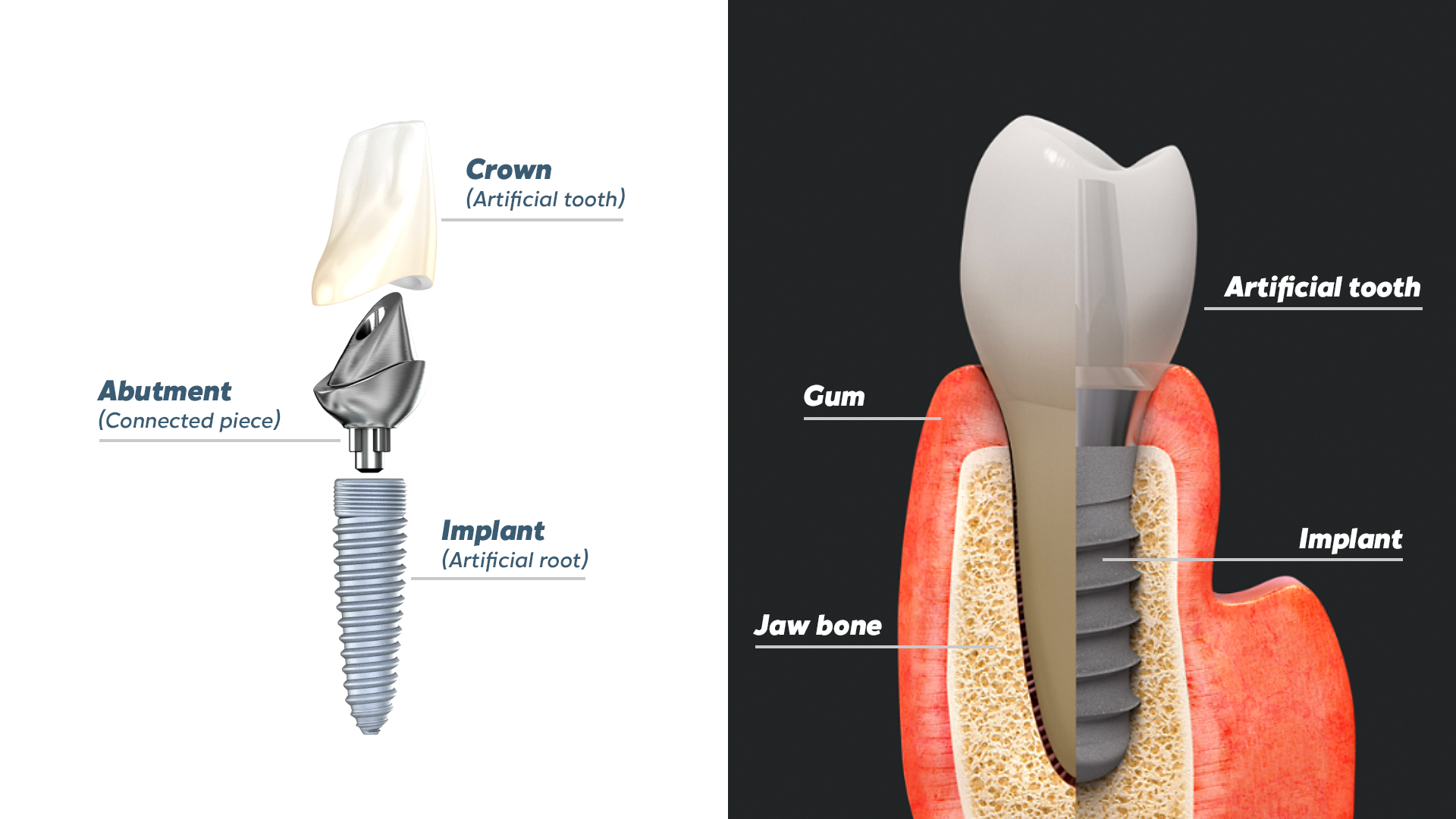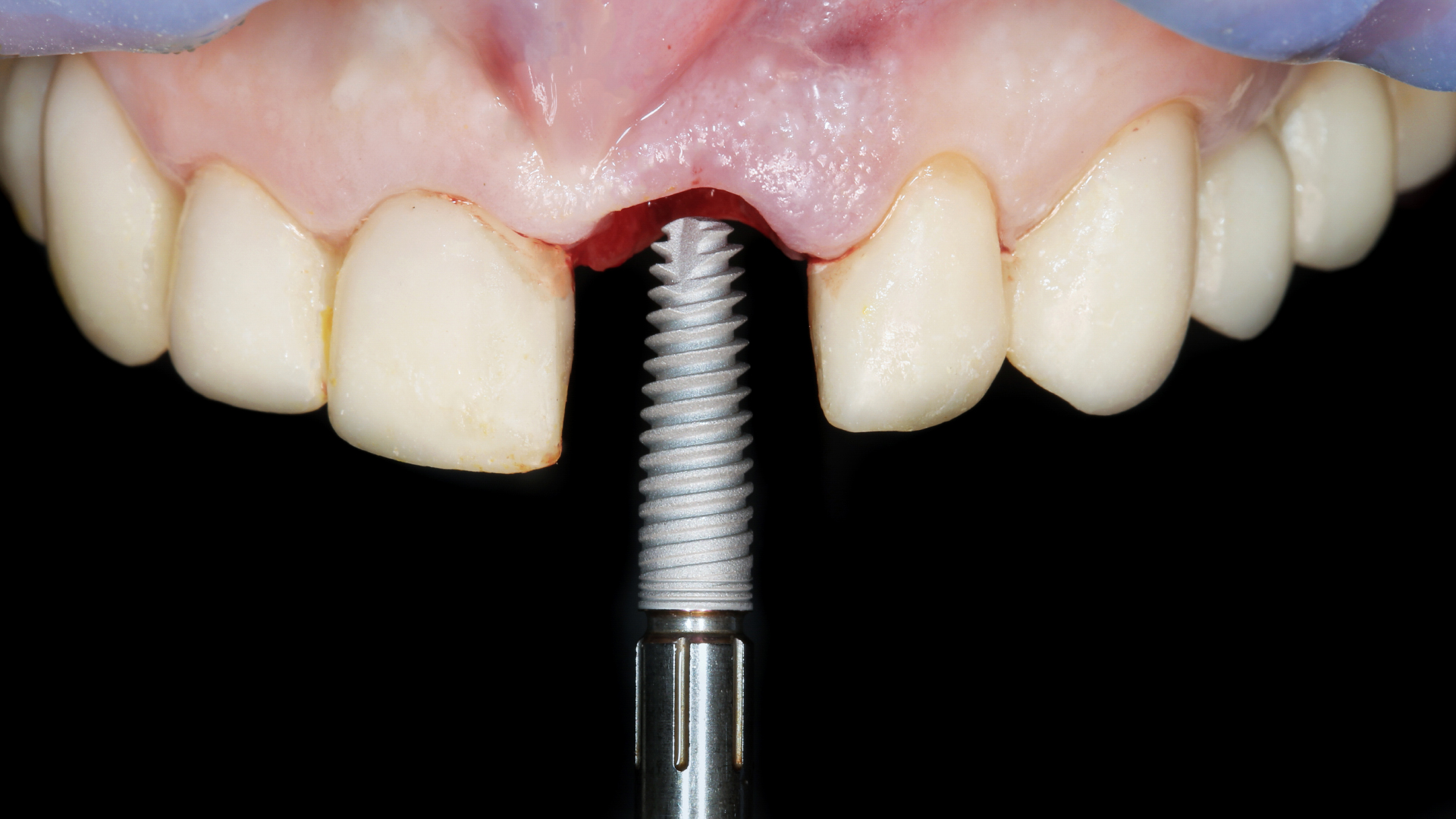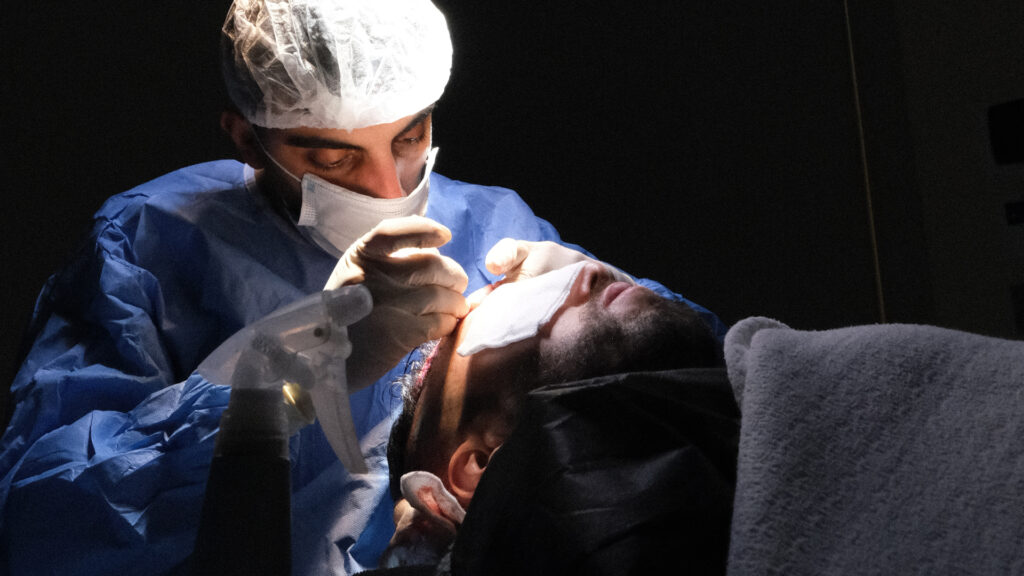40 years after the launch of the first implants, dental implants are now the safest solution for replacing one or more missing teeth. Now widely used in dental surgery, the dental implant consists of a rod, made from a material that is biocompatible with the human body (titanium or zirconia), which is implanted in the maxillary or mandibular bone and acts as an artificial tooth root. Adaptable to virtually all patients (several hundred different implants are available), the dental implant preserves the bone without affecting neighbouring teeth or the jawbone, and replaces an identical tooth in terms of function and aesthetics. Like a shock absorber placed between the tooth and the jawbone, the dental implant serves as an anchor for a dental crown, enabling patients to chew efficiently and comfortably, as well as speaking more clearly and smiling more attractively.

Why are dental implants so popular?
Thanks to their reliability, adaptability to each clinical case and durability, dental implants are an increasingly popular medical solution worldwide. According to the available statistics, the success rate for dental implants is close to 98%. In the long term, their reliability has been proven: according to studies published by the leading implant brands (Nobel Biocare, Straumann, etc.), 91% of patients who received implants 20 years ago remain satisfied with them. This trend is set to continue: dental professionals are predicting sustained growth in demand for implants over the next few years, thanks in particular to scientific and technological advances. The growing application of computer-aided design technologies, as well as artificial intelligence and nanotechnologies, should accelerate the spread of dental implants, making them less invasive, easier to fit and more affordable for a greater number of patients. For example, the nano-coating of titanium implants modified with Nano ZnO would help to reduce the adhesion of bacteria, thereby improving the effectiveness of orthopaedic implants and reducing the risk of infection or rejection of the implant by the bone.

The advantages of dental implants
- Aesthetic and functional restoration: thanks to dental implants that fill a partially or completely edentulous gap, patients can smile again with all their teeth, as well as regaining normal mastication.
- Conservation of the alveolar bone: when a tooth is missing, the alveolar bone is no longer used and gradually retracts, leading to physiological complications. The presence of an implant in the jawbone, imitating the dental root, prevents bone retraction and allows the patient to regain better oral and dental health.
- A long-lasting solution compared with other options: when a patient has one or more implants fitted, it’s for life. With good oral hygiene, it is possible to keep the same dental implant for 20 or 30 years, or even longer. Of course, it may be necessary to change the dental crown that is attached to the implant, if the ceramic of the crown is damaged or chipped, or if the discolouration is too visible. But this treatment is much more solid and durable than all the other solutions available, such as fixed dentures or bridges.

Why is it essential to be aware of the risks?
As with any medical or dental surgical procedure, implantology is not without risks, even if these remain very limited. It is therefore essential for all patients wishing to have dental implants fitted to carefully weigh up the advantages and disadvantages, as well as the risks involved, of having one or more dental implants placed.
Making an informed decision about implants
Choosing dental implants must be a carefully considered decision: an implant is for life, and once it has been fitted, there is no going back. This choice also requires a substantial financial investment, in the region of £300 (in Turkey) to £1,500 (in the UK) per implant. Don’t hesitate to seek advice from different dental practices, to make sure that the choice of dental implants is the best one for the health of your teeth and your finances.

Adopting the right reflexes before, during and after installation
The placement of implants is an invasive surgical procedure that should not be taken lightly. Your dental surgeon will impose a quarantine on smoking and alcohol for at least ten days before the operation and for at least two weeks afterwards, to facilitate osseointegration of the implant into the bone and healing of the gums. A period of two to four months is needed for the implant to integrate properly, before the crowns are fitted. During this period, the patient must strictly comply with the implantologist’s instructions in order to ensure successful implantation. Similarly, the durability of implants does not depend solely on the material used, although it is strongly recommended that patients choose the best brands (Straumann, Nobel Biocare, etc.). Dental prostheses may be false teeth, but excellent oral hygiene is just as important as for your healthy teeth, to avoid complications and make them last. If you eat too much sugar or too much fat, it’s time to opt for a healthy diet that won’t threaten the good health of your teeth. And to keep your new teeth sparkling, don’t overindulge in tobacco, coffee or tea, which stain the enamel of your teeth and the porcelain of your dentures. Above all, follow your dentist’s recommendations and prescriptions to the letter.

Knowing how to react appropriately in the event of complications
After implants have been placed, localised pain, bleeding or gum inflammation may occur. Take the anti-inflammatories and/or painkillers prescribed by your dentist, and apply ice cubes wrapped in a flannel to the cheek at the site of the pain. If the pain persists, consult your dentist or the dental surgery that performed the operation as soon as possible to determine the cause of the pain as accurately as possible.
Possible risks and complications
Implant surgery is considered to be a low-risk operation in terms of bleeding, and presents no more risks than any other surgical procedure, when all surgical protocols are followed: infectious, haemorrhagic, anaesthetic and drug interaction. However, when the patient’s state of health is impaired – allergies, cardiac risks, immunodeficiency diseases – the dental surgeon may consider alternative solutions to dental implants, such as bridges or removable dentures. It is therefore imperative that patient care begins with a thorough medical interview, enabling a detailed medical and dental assessment of the patient to be drawn up and any chronic illnesses to be identified, helping the implantologist to propose a course of treatment tailored to each patient’s state of health.

The importance of a full pre-operative assessment
Analysis of medical history
A full pre-operative assessment begins with an analysis of the patient’s medical history, as certain cardiovascular, bone (osteoporosis) or cardiac (cardiomyopathy, valvulopathy, etc.) diseases, immunodeficiency or certain cancers may preclude the fitting of dental implants. Similarly, dental implants are not recommended for patients with diabetes, haemophilia or blood circulation problems.
Dental and radiological examinations
The medical interview must be supplemented by a thorough dental examination, including a panoramic X-ray of the jaw to determine the state of the bone, and the possible need for a bone graft or Sinus Lift prior to implant placement.

Determining eligibility for implant placement
These dental, bone and medical examinations enable the dental surgeon or implantologist to determine the patient’s eligibility for implants and the type of implants required. Because every patient is different, there are all types of implants adapted to each situation: short or long implants, basal or zygomatic implants, extraction of the tooth followed by immediate insertion of the implant, or delayed by several weeks to allow better osseointegration of the implant and healing of the gum, etc.
Finally, when all the indicators are in the green for implant placement, there remains one particularly decisive factor, even if it is not physiological: the patient’s budget. In the UK, an implant alone can cost between £1,000 and £1,500, and is not covered by the NHS. If the patient’s finances do not allow him or her to consider having implants fitted in the UK, a particularly interesting solution is available: dental tourism, which allows the patient to reduce his or her budget by 60 to 80% by going abroad for dental treatment.

Factors that increase the risk of complications
Smoking and poor oral hygiene
Smoking and poor oral hygiene are the main sources of risk identified by implantologists. Both can be controlled by the patient, who can ask for professional support to reduce their tobacco addiction, and follow their dentist’s advice to improve their dental hygiene. However, it is important to stop in time: a recent study by the Pasteur Institute revealed that the harmful effects of tobacco remain in the human body for ten to fifteen years after the patient has stopped smoking, continuing to affect the immune and genetic systems during this period.

Advanced age
The advanced age of patients is no longer a risk factor for the placement of dental implants. While the first dental implants were not suitable for elderly patients with complex anatomical conditions, this is no longer the case today, thanks to the use of smaller implants requiring less invasive surgical procedures. Implant-supported dental prostheses, such as the All-On 4 (on 4 implants) or All-On 6 (on 6 implants) systems, are perfectly suited to edentulous elderly patients. Their benefits far outweigh the risks: prevention of bone atrophy, muscular coordination, muscular efficiency, etc. Implants improve the masticatory efficiency and quality of life of edentulous elderly patients. However, meticulous maintenance and regular monitoring must be carried out to avoid complications.

Immunodepression
Endogenous infectious risks are defined as the risk of infection of a patient, following surgery, by bacteria of internal origin (endogenous). In particular, they can cause cardiovascular problems which, if not identified early on, can endanger a patient’s life. In the UK, in cases of dental implantology, the Medicines and Healthcare products Regulatory Agency (MHRA) considers that for immunocompromised patients, “the balance between the benefit of the procedure and the risk of infection should be taken into account” by the dental professional. On the other hand, when a patient has infective endocarditis (an internal infection of the heart, generally caused by streptococci or staphylococci), dental implantology is contraindicated. These cases can normally be identified in advance, using the patient’s medical records and/or a blood test to identify these problems.

Implant positioning and bone quality
The positioning of the implant must be perfectly controlled by the implantologist, so as not to compromise the stability of the peri-implant tissues (superficial periodontium, gingiva and deep periodontium) into which the implant will be inserted. According to scientifically established protocols, each implant must be oriented horizontally, vertically and sagittally (from front to back, perpendicular to the axis of the human body). Incorrect positioning can weaken the periodontium and ultimately threaten the stability and survival of the implant. It can also damage the roots of adjacent teeth, with aesthetic and masticatory consequences for the recipient.

Similarly, bone quality is a determining factor in the success of an implant: the bones of the maxilla (upper jaw) and mandible (lower jaw) are classified according to their location, composition and bone density. They have different resistance, elasticity and tension factors around the implant, directly influencing the success rate of implantation of the dental implant in the bone. It is therefore essential that the implant operation is carried out by a particularly skilled and experienced medical team to ensure that these positioning and bone quality criteria are taken into account. For patients suffering from osteoporosis, implants are not recommended.

Diagnostic errors and medical incompetence
One of the major risks a patient may face when having an implant fitted is incompetence on the part of the dental surgeon. And this applies regardless of the country in which the treatment was provided. The implant may have been placed in the wrong place, incorrectly, making it impossible to position the dental crown it is to receive, or threatening the long-term stability of the dental prosthesis. Incorrect diagnosis, with implantation without bone grafting or sinus lift when the patient’s bone condition requires it, can also occur. These errors can have harmful consequences for both the patient’s mastication and health, causing chronic sinusitis, for example, and forcing the patient to undergo an operation again to remove the implant from the jawbone before it is re-implanted. There are many testimonies from victims of medical or dental errors, revealing not only the suffering of patients, but also their obligation to have paid for the same operation twice. Very few patients have the courage to sue for medical error or take their case to the relevant regulatory bodies. Hence the absolute necessity of carefully choosing a dental clinic and implantologists who are highly experienced and offer the best guarantees of post-operative follow-up.

Risks during surgery
Dental implant surgery can entail risks when the implantologist or dental surgeon carries out the procedure. These risks are particularly minimised when the professional complies with all surgical and dental protocols.
Bleeding
There is little risk of bleeding when a dental implant is placed. During insertion, a small section of the gum is cut and lifted, then closed again after implantation. Bleeding is therefore limited, and patients suffering from haemophilia are not candidates for this type of procedure.

Nerve damage
During implant surgery, the dental surgeon must avoid several anatomical obstacles, in particular the inferior alveolar nerve, under the mandibular premolars and molars (lower jaw). When the tip of the implant comes into contact with the nerve, it causes a lesion, and can be a source of severe, permanent pain for the patient, which he or she will not feel until the effects of the anaesthetic have worn off. A neuropathic complication that is difficult to diagnose and treat, but when protocols are followed and the surgeon is experienced and hasa thorough knowledge of dental anatomy, the risks are very limited. They can be avoided when the surgeon works with a “Cone Beam”: this X-ray system produces volumetric cone-beam imaging, known by the acronym CBCT (Cone Beam Computed Tomography), which enables the professional to carry out in-depth pre-implant planning. In the event of nerve damage, the implant must be removed, and high-dose anti-inflammatory and/or anti-epileptic drugs will be prescribed.
Perforation of the maxillary sinus
When an implant is placed in the back of the upper jaw, endo-sinusal complications can occur, when the implant perforates the sinus membrane. This can lead to infection, chronic sinusitis in the patient, or a bleeding complication. A surgical incident due to the implant being placed too close to the sinus membrane, which can be avoided by performing a Sinus Lift, prior to implantology, to reinforce the sinus membrane and give the implant more room to insert into the jawbone. Here again, this type of complication can be avoided by a perfect knowledge of the patient’s anatomy, thanks to the use of a volumetric digital X-ray of the “Cone Beam” type.

Allergic reaction to anaesthesia
Generally, a local anaesthetic is all that is required for a dental implant. More rarely, a general anaesthetic may be prescribed. In this case, an anaesthetist will be part of the medical team during the pre-operative interview. Whether local or general, anaesthesia must be preceded by a pre-anaesthetic interview to identify any allergic reactions the patient may have had prior to the operation, in order to identify a risk factor for allergy to an agent administered prior to the operation. Over 20% of patients report an allergy to antibiotics, analgesics or anti-inflammatories. Even if it is difficult to prove their allergic origin (few patients describe anaphylactic shock), the dental team must be able to suggest appropriate dilutions, predictive tests and/or alternatives to the usual anaesthetic products (ammonium ion, curare, etc.). An error in administering an anaesthetic can have fatal consequences for the patient’s health.

Possible complications after fitting
Infection and peri-implantitis
Peri-implantitis, the most common complication following the insertion of a dental implant, is an infection of the dental implant. More common in patients exposed to certain factors (smoking, diabetes, oral hygiene, specific drug treatments, etc.), peri-implantitis infection can lead to rejection of the dental implant. It manifests itself through various symptoms: bleeding of the gums, bone loss, inflammation of the gums around the implant, localised pain around the implant, formation of pus around the prosthesis, mobility of the implant, etc. It must be treated urgently and specifically, which is why it is so important to contact the dental surgery responsible for placing the dental implant as soon as some of the warning symptoms appear, so that a specific procedure can be carried out.

Failure of osseointegration
In rare cases, the rejection of a dental implant is caused by the failure of osseointegration of the implant, when it does not fuse with the patient’s bone due to a lack of bone density. This type of failure is very rare, as the dental surgeon will have previously analysed the patient’s bone density and carried out a bone graft to compensate for insufficient bone density. Implant failure can also be caused by an allergy to titanium, the biocompatible material from which most implants are made. In this case, the professional must remove the implant and offer to replace it with a zirconia implant. Unlike titanium, an ultra-resistant rare metal, zirconia is a synthetic ceramic obtained from zircon sand. Particularly resistant, zirconium dioxide, the scientific name for zirconia, is made from baddeyelite, a mineral extracted from volcanic rocks.

Pain and swelling
In the days following the insertion of a dental implant, localised pain and swelling of the gums may occur, which can be soothed by the prescription of anti-inflammatory drugs and painkillers such as paracetamol. But when this pain and/or swelling persists for more than a week, it may be a warning sign of the complications described above. If this is the case, patients should consult their dentist as soon as possible.

Aesthetic or functional problems with the prosthesis
After the period of several weeks required for the implant to osseointegrate and the gums to heal, the dental surgeon will proceed, during a second session, to fit the dental crown attached to the dental implant. If, in the days that follow, the patient experiences aesthetic problems with the prosthesis, or functional problems when chewing food, he or she should consult the dentist again, so that the dentist can rectify the shape of the crown and ensure that it aligns impeccably with the rest of the teeth. If necessary, he will have to make a new cast and have a new, better-fitting crown made by the dental technician.

How can you reduce risks effectively?
Even if the risks remain rare and limited in implantology (97% success rate), it is better to take every precaution beforehand to avoid finding yourself in the remaining 3%. Firstly, by choosing a dental surgeon who specialises in implantology, has extensive experience in the field and uses the latest technology available, particularly in digital imaging.
With its negative influence on blood circulation, smoking is the worst enemy of surgery, particularly in the mouth. If they can’t quit completely, patients should stop smoking at least ten days before the operation, and not resume during the period of gum healing and implant osseointegration (generally between two and three months). You should, of course, follow your dentist’s pre- and post-operative recommendations, and adopt impeccable oral hygiene. Finally, avoiding alcohol and adopting a healthy diet, rich in vegetables and fibre, and avoiding eating too much sugar (especially sugary fizzy drinks) and too much fat, can only be beneficial to the success of implantology and good dental health.

Why choose Body Expert for your dental implants?
Choosing to have one or more dental implants fitted represents a significant financial investment, in the region of £1,000 to £1,500 per implant in the UK, especially as neither the procedure nor the equipment is covered by the NHS. More and more patients are opting to have their implant treatment carried out abroad, saving between 40% and 80%, depending on the destination. And all this in a much shorter time than in the UK.

Turkey, a leading destination for dental tourism, is now the best alternative for having your teeth redone. As long as you choose your service provider carefully, who offers all the guarantees needed to ensure that the treatment goes smoothly, as well as the right legal protection in the event of a problem.
Body Expert, the market leader in medical tourism in Turkey, offers all these guarantees, with particularly high satisfaction rates from its patients (read the testimonials). This expert dental travel agency works with the best maxillo-facial surgeons and traumatologists in Turkey in ultra-modern clinics, using the best medical technologies and the best brands of implants for its patients, to offer them the best possible value for money, with personalised support throughout the process.

The support offered by Body Expert begins with the preparation of the medical-dental file and the estimates with a dedicated customer assistant. This is followed by the logistical organisation of the trip, from making appointments to booking hotels (4 or 5 star), right through to the VIP welcome at the airport. On site, all appointments are made with the dedicated assistant, who simultaneously translates all medical interviews into English. During surgery, the dental professional offers intravenous sedation, providing better pain management than in the UK. Support continues over the long term, after the patient returns home, with rigorous 24-hour post-operative monitoring.

7643 vues
0 commentaires
0






Il n'y a pas de commentaires pour le moment.